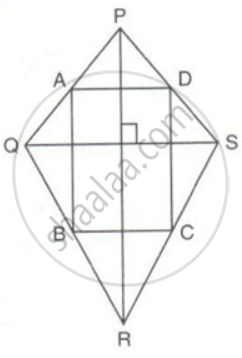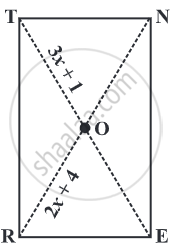Advertisements
Advertisements
Question
ABCD is a quadrilateral in which diagonals AC and BD intersect at a point O. Prove that: areaΔAOD + areaΔBOC + areaΔABO + areaΔCDO.
Solution

Since the diagonals of a parallelogram bisect each other at the point of intersection.
Therefore, OB = OD and OA = OC
In ΔABC, OB is the median and median divides triangle into two triangles of equal areas
Therefore, area(ΔBOC) = area(ΔABO) ..........(i)
In ΔADC, OD is the median and median divides triangle into the triangles of equal areas
Therefore, area(ΔAOD) = area(ΔCDO) ..........(ii)
Adding (i) and (ii)
area(ΔAOD) + area(ΔBOC) = area(ΔABO) + area(ΔCDO).
APPEARS IN
RELATED QUESTIONS
The diagonals of a rectangle intersect each other at right angles. Prove that the rectangle is a square.
Prove that the bisectors of interior angles of a parallelogram form a rectangle.
The diagonals PR and QS of a quadrilateral PQRS are perpendicular to each other. A, B, C and D are mid-point of PQ, QR, RS and SP respectively. Prove that ABCD is a rectangle.

Length of one of the diagonals of a rectangle whose sides are 10 cm and 24 cm is ______.
Diagonals of a rectangle are ______.
If one diagonal of a rectangle is 6 cm long, length of the other diagonal is ______.
Diagonals of a rectangle are equal.
Diagonals of rectangle bisect each other at right angles.
A photo frame is in the shape of a quadrilateral. With one diagonal longer than the other. Is it a rectangle? Why or why not?
